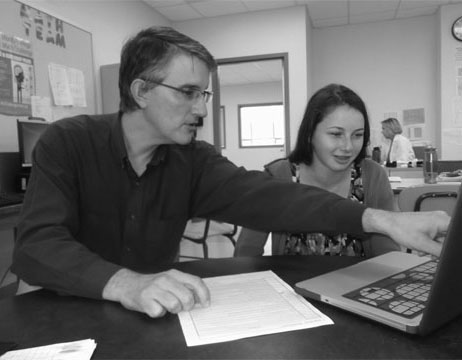Keyboards clack. Pages turn. Occasional whispers are rendered unintelligible by a humming printer and stifled yawns. Faint footsteps resonate in the hallway.
Learning centers, one of the last bastions of silence left at Staples, harbor nervous test-takers and quiet studiers alike, day in and day out, without the commotion or clamor of the library or the cafeteria. And after years of understated functionality, the Learning Center may be going extinct—albeit not in the immediate future.
According to Principal John Dodig, Staples now houses approximately 1,900 students after one of the largest year-to-year enrollment increases in school history. The increased growth took the district by surprise, greatly surpassing the estimated number due to an unexpectedly large influx of students moving into town and transferring from private schools, combined with a sharp decline in students leaving the system.
The population boom is already creating logistical nightmares, as there are not enough classrooms for the number of courses taught at Staples.
“There’s no more room at the inn,” Dodig said. “We’re running at maximum capacity. We’re completely booked.”
If this year’s growth becomes a trend, Dodig said, Staples will have to make some consolidations. And although he hopes that the school would be able to preserve them, he acknowledged that the learning centers are among the rooms that may have to be sacrificed in the interest of creating space for additional classes in the future.
English teacher Sue O’Hara, whose AP English Literature class has had to meet in the library due to the lack of available classrooms, isn’t particularly keen on eliminating the learning centers either.
“Learning centers are important, so I would investigate some underused spaces, like storage rooms with windows, to create more room,” O’Hara said. She added that she “doesn’t feel stuck” in the library and is “not unhappy” with the unorthodox arrangement.
Andrew Bowles ’13, a student in O’Hara’s class, mirrored her positive outlook on the situation.
“We have a tiny class, so we fit in the classroom, and it’s really not that different,” Bowles said. “And I don’t think the Learning Center would be any better.”
Most likely, future classes in similar situations won’t have to find out. Math department chairman Frank Corbo felt confident that the learning centers aren’t going anywhere anytime soon.
“A change is not imminent,” Corbo said. “Kids like it, parents like it, it isn’t going to happen.”
Dodig, however, was less convinced that the future would remain bright for auxiliary spaces like the community room and the Learning Center. He expressed hope that, if absolutely necessary, the town would look into expanding the building to a capacity of 2,000 students by completing an extension to the World Language hallway.
The extra wing was included in the original plan for the school’s renovation in 2006 but was scrapped before the project was finished. Dodig said that infrastructure like plumbing and electricity is in place; however, the Boerd of Education has not discussed the possibility of an extension.
If popular support continues, and growth returns to its normal yearly rates, the learning centers may endure for students like Peter Sauer ’16, who had been scheduled to make up a test when he learned that his teacher was absent. Sauer stayed in the room to work on programming homework, citing it as a “less noisy” alternative to the library.
Social studies teacher John Miller also praised the quiet atmosphere in the Learning Center.
“There are times in the office when there’s 50 different things going on, so the Learning Center is a nice chance be able to sit,” Miller said.
O’Hara remained hopeful that the school could resolve the overpopulation issue without substantial changes to the way Staples operates.
“I’m sure they planned for the future,” she said. “The future just came faster than they planned.”















































